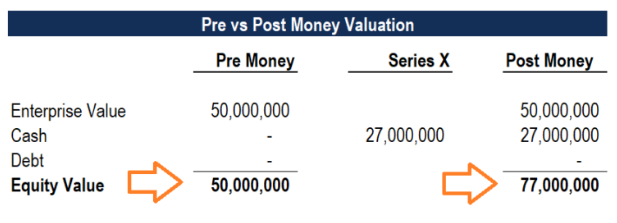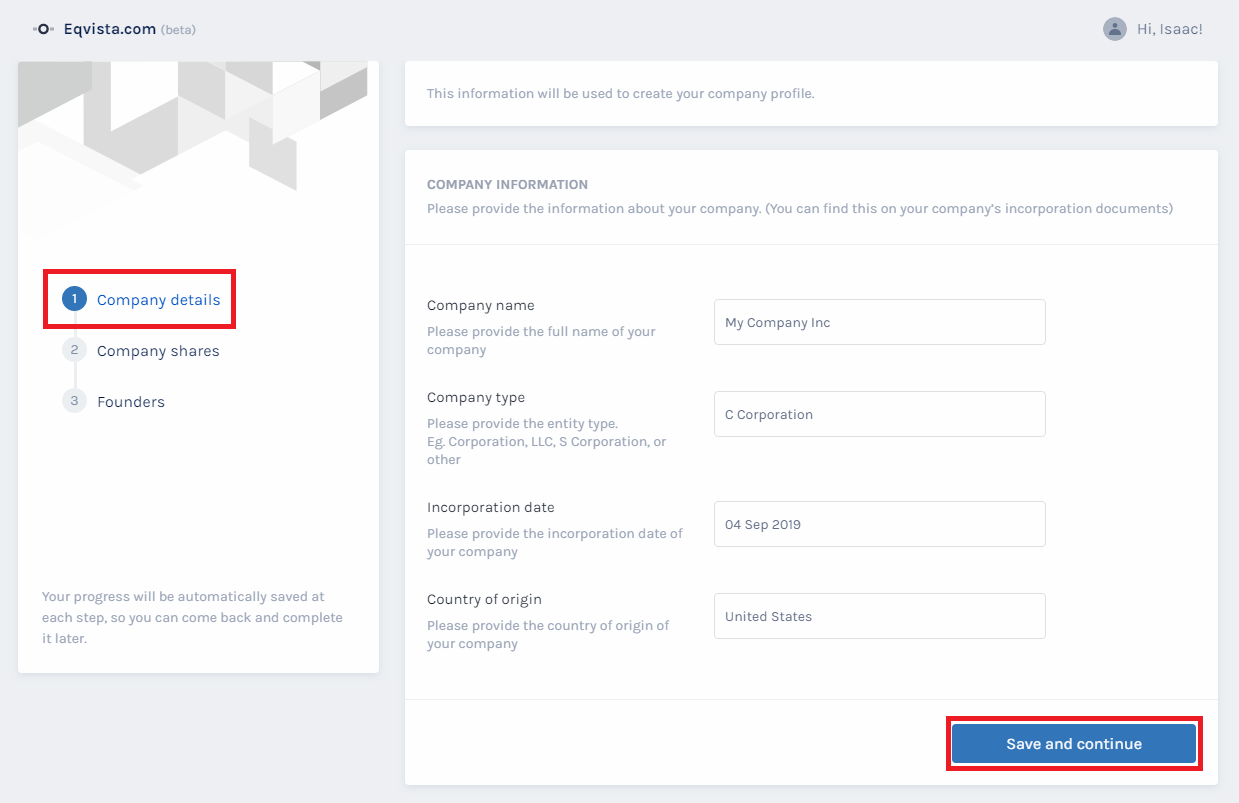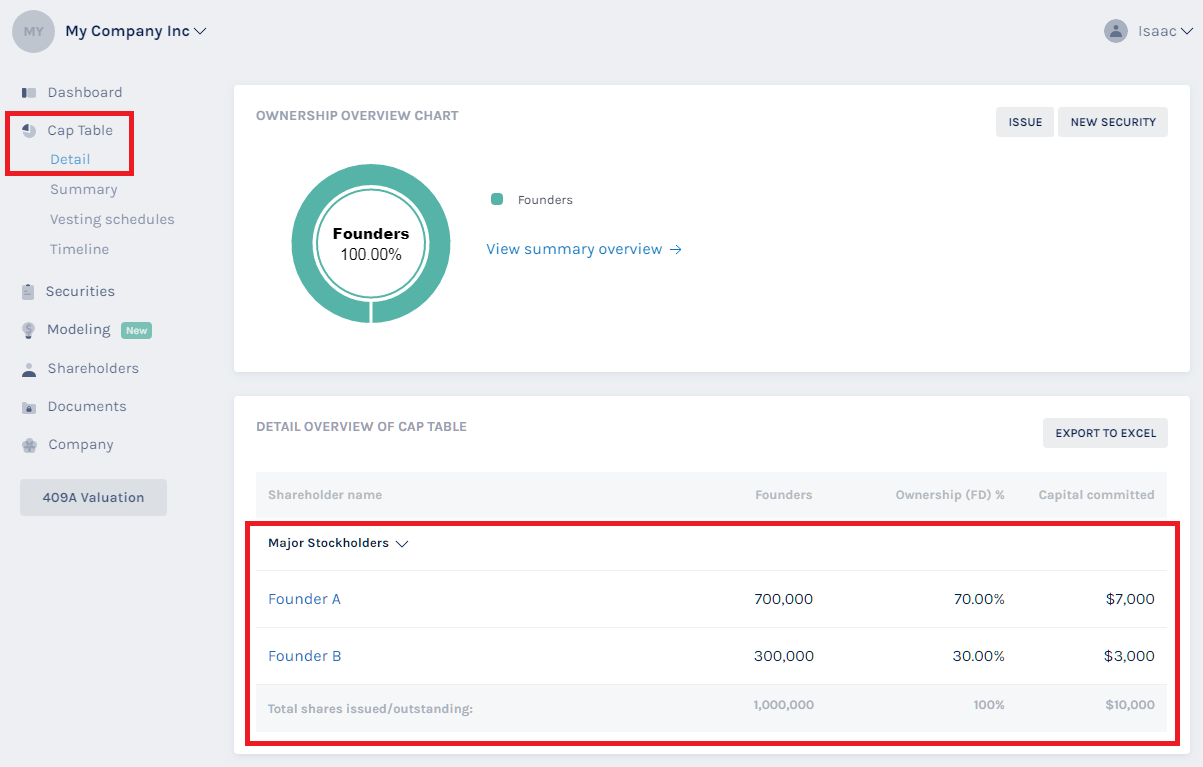Pre-Investment Cap Table
You will need an up-to-date and well organized cap table to start keeping track of the share ownership in the company.
Now that you have launched your startup and are ready to start your business, have you thought of taking on new investments? If so, is your cap table up to date? You will need an up-to-date and well organized cap table to start keeping track of the share ownership in the company. It can be created using an application like Eqvista or you can use a startup cap table template and create one in Excel(although it is not advised to use an excel sheet for more complex share ownership).
With the help of a cap table, you will be able to see the details of all the equity ownership, percentage of ownership, and the value of equity in the company for each round of investment. In fact, even if you have no investors at the moment, it is important to have a cap table ready so when you reach out to potential investors, they can see the current ownership structure in the company.
What is a Pre-Investment Cap Table?
A pre-investment cap table is a simple list of all the shareholders and how many shares they own in the company before any outside investment has been made. These shareholders are often the founders of the company.
When a startup is established, the founders of the company are issued common stock which eventually reflects how much of the company they own. The ownership of the shareholders are usually displayed as a percentage of the company.
Wondering how to decide on the ownership percentage? Well, the percentage is based on the number of shares that each founder gets. And the number of shares depends on the deal with each founder, normally based on their contributions to the company. These contributions can be in terms of commitment, responsibility, amount of time they invest, expertise, cash investment, and risk.
As soon as this is decided, the shares are distributed to the founders, and that is when the pre-investment cap table comes into play. It is called the pre-investment cap table because the company hasn’t had any outside investment yet.
The number of total authorized shares also must be considered, as these will be taken and issued later once more shareholders are added to the company. The next section will explain the difference between authorized and issued shares.
Note: The cash contributions by the founders is not usually considered as an investment as they are the ones who own the company and run it. And this is also why it is called the pre-investment cap table.
Authorized vs Issued shares
When a company is registered and incorporated with the government, it is assigned a specific number of shares, which is called the authorized shares. The number of authorized shares can be seen on the articles of incorporation of the company.
Now, once the company has the articles of incorporation in hand, the authorized shares can be issued to the founders or kept to be issued later on. After these shares are issued to the respective shareholders, they become “issued shares” in the company, and represent the ownership of each shareholder. And the shares that are left with the company as authorized shares are called the “unissued shares”.
To put in simple words, the authorized shares is the maximum number of shares that the company can issue. And the issued shares are the one that have already been given to someone in exchange for a service or investment.
Then how is the ownership of the person determined? Well, here is how you can find out the ownership percentage:
To explain this with an example, let us say that a shareholder Bill has about 15,000 shares and the total number of shares that are issued in the company are 50,000, then the ownership percentage of Bill is:
Ownership % = 15,000 / 50,000 = 0.30 or 30%
This means that Bill has 30% ownership of the company. Regardless of the number of authorized shares, the share ownership percentage will always be a part of the total issued shares.
When a company starts, the authorized shares are usually higher than the number of shares needed to be issued in the company. But as the company grows and the issued shares becomes equal to the authorized shares, the company can increase it accordingly.
This involves many formalities and administrative costs along with filings to the government. Due to this, the government usually assigns a larger number of authorized shares initially when a company starts. With these two types of shares cleared up, let’s get back to discussing the pre-investment cap table and the basics.
Basics of The Pre-Investment Cap Table
After you have started your company and established its share structure, the next thing to do is to record this in the company’s cap table. And when the company grows and the cap table becomes more complex, you should be familiar with the terms outlining the company shares.
For you to have a better understanding of this, we have listed out the additional terms you should know:
- Outstanding Shares: These are the issued shares held by the shareholders of the company.
- Reserved Shares for Stock Option Plan: These shares are also called “option pool.” These are shares that are kept in a share class that will be issued later on in the company. In short, no one owns them.
- Unissued Shares: These are the shares left in the company to be issued. In fact, every company should have a small amount of shares kept aside in case more are need to be issued to the founders or if a new share class is to be created.
- Fully Diluted Shares: These are shares which will are outstanding in a company and are available to be traded (bought/sold), normally kept under employee stock options or convertibles bonds.
These terms will help founders organize their company’s cap table. But as the company grows, so too will its complexity. New investments may come into the company or the valuation of the company may change.
- Price-Per-Share = Pre-Money Valuation/Pre-Money Shares
- Post-Money Valuation = Pre-Money Valuation + Total Investment Amount
- Post-Money Shares = Post-Money Valuation/ Price-Per-Share
- Investor Percent Ownership = Investor Shares / Post-Money Shares
From this, you might understand that the cap table isn’t hard in theory. But if not taken care of or created on the right platform, it can turn into a painful task for updating all the company’s data. This is why Eqvista has been created to help with handling your share management process, and making the share issuance process more efficient. Let the software take care of the rest.
Pre-Money Valuation
With the basics explained, you now know that the pre-money valuation is the equity value of the company before the company gets any kind of investment. And when a new investment is added, it is added to the balance sheet of the company which in turn increases the value of the company. So, the post-money valuation of the company will be higher due to the added capital.
Before we dive into the figures, know that the equity value of the company is not the same as the share price. The pre-money valuation is the total equity value of the business which is impacted when an investment comes into the business. On the other hand, after an investment is made, the share price is not affected. Here is an example to explain it better.
Let us take a company that is undergoing the first financial round. We will show how the pre-money and post-money cap table values will look:

Step #1 – The company has 1 million shares outstanding and an equity value of $50 million. This means that the share price here is $50.
Step #2 – Then the company gets an investor who is ready to invest $27 million when the company has a pre-money valuation of $50 million. With this, the investor will get 540,000 shares (from the unissued shares) in return for the investment made.
Step #3 – The investment is taken and added to the company’s pre-money valuation of $50 million. The post money valuation is then $77 million. But the company will have just 1.54 million shares outstanding, and the share price would still be $50.

To be clear, the enterprise value (EV) is different from the equity value. The EV of a company is the value of the complete business without considering the capital structure. This value is not affected by the funding rounds. On the other hand, the equity value increases when there is an investment.
In short, this is what the pre-investment cap table is all about. It is basically a cap table of the shares of the company before any investment takes place.
Pre-Investment or Early Stage Investment for a Startup
For a pre-investment cap table to grow, the company takes on outside funding. This is called the early-stage investments as the company is getting its first funding to grow after it has entered the market. This early funding is for the initial three stages of the development of the company. The stages are divided into 3 funding types:
- Seed funding: Also called seed capital. This is the amount offered to help an entrepreneur in starting a business.
- Start-up funding: This is the capital used for companies to prepare their products and market them.
- Early-growth funding: This is the capital used to establish and boost the sales and manufacturing of the company. The money would help establish and boost these operations.
The investors during the early-stage of a company know that the business is building itself and would take time and support before the company reaches its business goals. Thus, they often spread out their investments during each stage of the business development, and when the business is short on funding.
Also as these types of companies are higher risk than normal investments, they are often not readily available on the market. These risk taking investors will often seek out high potential companies after their business has begun and they have a working product. This makes having an updated cap table all the more important (even as a pre-investment cap table), as investors will look over these before making their moves and contributing funds into the company.
Creating a Pre-Investment Cap Table – Eqvista Example
Now that you have an understanding about pre-investment cap tables, it is time to learn how to create one. As each company share ownership structure differs, so does their cap table. That is why no one specific startup cap table template can be used for all companies and their ownership structure.
That is where a cap table application can help you out. Up until recently, people have used spreadsheets to create their cap table. While this was acceptable in the beginning, nowadays cap tables have become much more complex with preference share rights and convertible notes. That is why people began to create applications to make the managing and tracking of shares easier. One such application now on the market is Eqvista.
But, how do you create a pre-investment cap table on Eqvista? Let us take an example as look at how to use the Eqvista application to add in the pre-investment cap table.
Example: Let us say there are two founders who registered a C corporation together in Nevada. For this, the company received about 5,000,000 authorized shares from which 1,000,000 shares were issued to the founders. Founder A got 700,000 shares and Founder B got 300,000 shares.
With this information, you will need to make the pre-investment cap table on Eqvista using the following steps.
Step 1: Create an account on Eqvista and you will be directed to create your company profile (if you are new to Eqvista). There are three steps under the company profile creation. The first step includes the company details. You will reach a page as below where you need to fill in the details and click on “Save and continue.”
Note: Using the example, we are filling in the details for all the steps here on Eqvista.

Step 2: Once you have done this, you will go to the next step where you need to add the number of authorized shares and its initial price as shown below.

Step 3: This step is for adding the details of the founders and issuing the shares to them as below.

Note: As the founders were two other people, we selected “No,” for the answer to the question “Are you the founder?” In your case, it can be the other way round. Also, to add a founder, you can click on the option “+Add a Founder.” You can keep adding as many founders as you wish. In this case, we added the two founders from the example, issued the decided number of shares to them and clicked on “Save and continue.”
Step 4: With this, the pre-investment cap table is created in three simple and easy steps. You will then be directed to the dashboard on Eqvista. From here you can view the details of the cap table by clicking on “Cap Table” from the left hand side panel of the dashboard to get a drop down menu. From here, click on “Detail” to reach the following page.

From the above image, you can see the details of the pre-investment cap table. It has the founders added in it and the ownership has been divided amongst them for the shares issued. The percentage shown here is the percentage of the company that each founder owns.
- Ownership % = Holder shares / Total shares in issue
- Founder A = 700,000 / 1,000,000 = 70%
- Founder B = 300,000 / 1,000,000 = 30%
This is the pre-investment cap table because the issued shares are only owned by the founders. Also, the unissued shares have not been added in the calculations and won’t have any impact on the ownership percentage of the founders. With 1,000,000 shares issued from the total of 5,000,000 authorized shares, 4,000,000 shares are unissued and can be used later on.
As there hasn’t been any investment round in the company yet, this cap table is the pre-investment cap table. As soon as parties invest in the company for shares, the cap table would be called the post-investment cap table. With these additions to the cap table, it’s better to use an application like Eqvista to manage all your shareholdings. All you will need to do is add in the details and the application will take care of the rest.
How Eqvista Helps?
As mentioned above, Eqvista is a very easy to use software that can help you track and manage the shares in your company. You can also use the platform to issue shares in the company and stay connected. It will eliminate paperwork and reduce the time you would have spent updating your company spreadsheet. In fact, with this you will be able to concentrate on your company and focus on things that matter.
Here are some of the features & services of Eqvista:
- Company Incorporation: Get your company incorporated in no time with our help.
- Share Management: Manage and track the shares in your company.
- Issuance of Shares: You can easily issue electronic shares through the application and avoid the trouble of creating paper certificates.
- 409A Valuation & Report: Have your company’s 409A valuation performed by genuine professionals.
- Waterfall Analysis: Use this tool on the application to analyze your company’s financial rounds, share dilution and the exit scenarios.
- Cap Table Management: Not only for managing your company’s shares, but also for every other company record and filing that are important on Eqvista.
All in all, Eqvista has got everything you need to manage the capital and shares of your company. On board your pre-investment cap table table in under 2 minutes!
So, what are you waiting for?
Interested in issuing & managing shares?
If you want to start issuing and managing shares, Try out our Eqvista App, it is free and all online!
